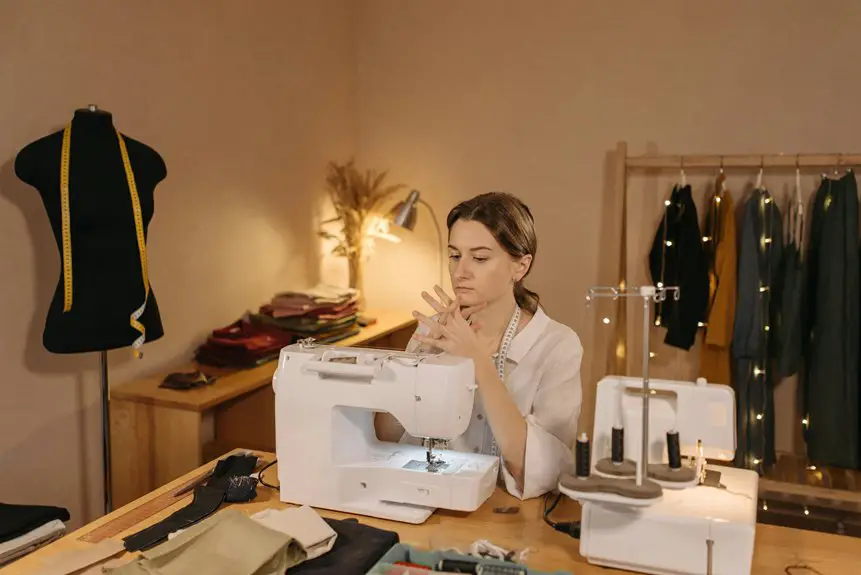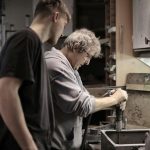When you manufacture nonwoven fabrics, you focus on selecting the right fibers and bonding methods to meet specific performance needs efficiently. You tackle challenges like material variability, machine uptime, and cost control while integrating automation to boost productivity. Sustainability is key, pushing you toward eco-friendly materials and energy-efficient processes. Staying ahead means innovating with new technologies and complying with evolving regulations. Explore these insights further to understand how manufacturers adapt and thrive in this dynamic industry.
Table of Contents
Key Takeaways
- Manufacturers prioritize fiber selection and bonding methods to ensure product quality and meet diverse end-use requirements.
- Maintaining consistent machine speed and minimizing equipment downtime are critical for maximizing production efficiency.
- Automation and Industry 4.0 integration reduce errors, optimize processes, and lower production costs in nonwoven fabric manufacturing.
- Sustainability drives material choices, with a focus on biodegradable fibers and energy-efficient machinery to meet regulatory and market demands.
- Ongoing innovation and collaboration are essential to develop multifunctional products and adapt to evolving consumer and regulatory landscapes.
Understanding the Basics of Nonwoven Fabric Production
Nonwoven fabric production involves bonding fibers together without weaving or knitting. You start by selecting fibers, which can be natural, synthetic, or a blend, depending on the desired properties.
Then, you create a web of these fibers through processes like carding or air laying. To bond the fibers, you use mechanical, thermal, or chemical methods. Mechanical bonding involves entangling fibers with needles or water jets, while thermal bonding melts fibers together, and chemical bonding uses adhesives.
Create fiber webs via carding or air laying, then bond them mechanically, thermally, or chemically for strength and durability.
You control factors such as fiber type, web formation, and bonding method to tailor the fabric’s strength, softness, and breathability. By understanding these basics, you can efficiently produce nonwoven fabrics suited for medical supplies, filters, or hygiene products.
This knowledge forms the foundation for successful manufacturing.
Key Challenges in Manufacturing Nonwoven Fabrics
When you’re manufacturing nonwoven fabrics, choosing the right materials can be tricky since each type affects the final product’s quality.
You also have to keep production efficient to meet demand without sacrificing consistency.
Balancing these challenges is key to successful nonwoven fabric production.
Material Selection Issues
Although selecting the right materials might seem straightforward, you’ll quickly find it poses several challenges that directly impact the quality and performance of nonwoven fabrics. You must balance factors such as fiber compatibility, cost, and end-use requirements. Choosing unsuitable fibers can lead to poor fabric strength or undesirable texture. Additionally, sourcing consistent raw materials can be tricky, affecting production reliability.
| Challenge | Impact | Consideration |
|---|---|---|
| Fiber Compatibility | Weak bonding, poor durability | Match fiber types |
| Cost Constraints | Increased production expense | Optimize budget |
| Availability | Supply chain disruptions | Secure reliable sources |
| End-Use Needs | Performance shortfalls | Tailor fiber properties |
| Environmental Impact | Sustainability concerns | Choose eco-friendly options |
Production Efficiency Challenges
Since production efficiency directly affects costs and output quality, you’ll need to address several critical challenges in manufacturing nonwoven fabrics.
First, maintaining consistent machine speed without compromising fabric integrity demands careful monitoring and adjustment. Equipment downtime can quickly erode productivity, so implementing preventive maintenance schedules is crucial.
Additionally, balancing energy consumption with performance requires optimizing process parameters to avoid waste. You’ll also face difficulties in handling raw material variability, which can disrupt continuous production flow.
Efficient workforce training guarantees operators can quickly troubleshoot issues and maintain steady operations.
Finally, integrating automation and real-time data analytics helps you identify bottlenecks and streamline workflows.
Technological Innovations Shaping the Industry
You’ll notice that advanced fiber bonding techniques are transforming how nonwoven fabrics hold together, boosting strength and durability.
Automation in production processes is also speeding up manufacturing while cutting costs.
Let’s explore how these innovations are reshaping the industry.
Advanced Fiber Bonding Techniques
Three cutting-edge fiber bonding techniques have transformed nonwoven fabric production, making materials stronger, lighter, and more versatile.
First, hydroentanglement uses high-pressure water jets to intertwine fibers without adhesives, enhancing fabric durability and softness.
Next, thermal bonding fuses fibers with heat, creating stable structures ideal for medical and hygiene products.
Finally, chemical bonding employs binders to secure fibers, offering flexibility in texture and strength.
By mastering these methods, you can tailor fabric properties to specific applications, improving performance and cost-efficiency.
These techniques also reduce environmental impact by minimizing chemical use or energy consumption depending on the process.
Embracing advanced fiber bonding lets you innovate continuously, meeting evolving market demands while maintaining quality and sustainability in your nonwoven fabric production.
Automation in Production Processes
Building on advanced fiber bonding techniques, automation in production processes takes nonwoven fabric manufacturing to the next level by boosting efficiency and consistency.
When you integrate automation, you reduce human error and speed up production cycles, ensuring every batch meets your quality standards.
You’ll find that automated systems allow you to:
- Monitor real-time data for immediate adjustments
- Optimize material usage to minimize waste
- Enhance machine uptime through predictive maintenance
- Streamline workflow with synchronized robotic arms
- Implement flexible production lines for varied product types
Quality Control and Assurance in Production
Although nonwoven fabric production involves complex machinery and processes, maintaining strict quality control and assurance is essential to guarantee the final product meets industry standards and customer expectations.
You need to implement real-time monitoring systems that track critical parameters like fiber distribution, web uniformity, and bonding strength throughout production. Regular sampling and testing help you identify defects early, ensuring consistency in fabric thickness, tensile strength, and absorbency.
By establishing standardized inspection protocols and training your team thoroughly, you reduce variability and improve reliability. You also benefit from documenting every batch’s quality data, which supports traceability and continuous improvement.
Ultimately, your focus on quality control not only boosts product performance but also strengthens your reputation and customer satisfaction in a competitive market.
Sustainability Practices and Environmental Impact
Since nonwoven fabric production can consume significant resources and generate waste, you need to adopt sustainability practices that minimize environmental impact.
Focus on optimizing energy use, reducing water consumption, and managing waste responsibly. Implementing eco-friendly raw materials and recycling initiatives also plays an essential role.
Here are key strategies to take into account:
- Use biodegradable or recycled fibers to lower environmental footprint
- Optimize machinery for energy efficiency and minimal emissions
- Implement closed-loop water systems to cut water waste
- Develop waste management plans prioritizing reuse and recycling
- Monitor and report environmental performance regularly to guarantee compliance
Market Trends and Future Outlook for Manufacturers
As you adopt sustainable practices in nonwoven fabric production, staying aware of market trends can help you align your efforts with industry demands.
The growing focus on eco-friendly materials and circular economy principles means you’ll likely see increased demand for biodegradable and recycled nonwovens.
Rising eco-consciousness boosts the demand for biodegradable and recycled nonwoven fabrics in the market.
Additionally, the healthcare sector continues to drive growth, especially for disposable medical products, so investing in advanced filtration and antimicrobial technologies could give you a competitive edge.
Automation and digitalization are reshaping manufacturing efficiency, so embracing Industry 4.0 tools will help you reduce waste and costs.
Looking ahead, expect heightened regulatory scrutiny and consumer awareness, pushing you to innovate responsibly.
Frequently Asked Questions
What Are the Most Common Applications of Nonwoven Fabrics?
You probably think nonwoven fabrics just lounge around as fancy dust collectors, but they actually star in diapers, medical masks, filters, and wipes. You’re touching their magic daily without even noticing—those fabrics never get a day off!
How Do Nonwoven Fabrics Compare to Woven Fabrics in Cost?
You’ll find nonwoven fabrics generally cost less than woven ones because they require less time and fewer resources to produce. Their manufacturing process is simpler, making them a budget-friendly choice for many applications.
What Raw Materials Are Primarily Used in Nonwoven Fabric Production?
You’ll mostly use synthetic fibers like polypropylene, polyester, and sometimes natural fibers such as cotton or rayon. These raw materials give nonwoven fabrics their unique properties and cost-effectiveness compared to traditional woven fabrics.
Can Nonwoven Fabrics Be Recycled Effectively?
You can recycle some nonwoven fabrics, but effectiveness varies. Materials like polypropylene recycle better, while mixed fibers complicate the process. You’ll need proper sorting and facilities to maximize recycling potential and reduce environmental impact.
How Long Does It Take to Produce a Batch of Nonwoven Fabric?
It usually takes a few hours to produce a batch of nonwoven fabric, depending on the technique and equipment used. You’ll find processes like spunbond or meltblown vary in speed, affecting overall production time.
- Does Chiffon Fabric Stink - July 15, 2025
- Does Chiffon Fabric Affect the Economy - July 15, 2025
- Does Cotton Fabric Have a Nap - July 15, 2025




